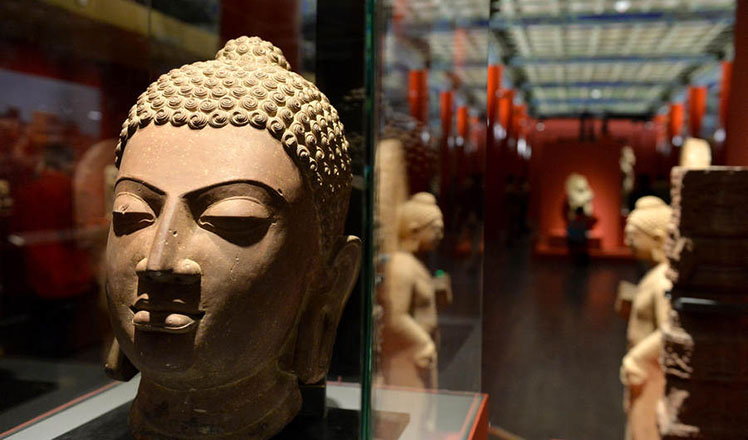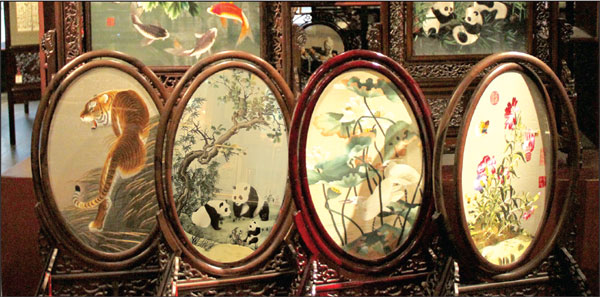Romance Of Silk
Updated: 2016-10-03 08:41
By Huang Zhiling(China Daily)
|
||||||||
Cultural traditions of the ancient Shu kingdom are being preserved at a museum in today's Sichuan province, Huang Zhiling reports in Chengdu.
Zivit Sari, a resident of Haifa, Israel, was happy to receive a brocade purse from a friend in Chengdu, Southwest China's Sichuan province, during his visit to the city in January.
Sari, a silk lover, says the gift that was made at the Chengdu Shu Brocade and Embroidery Museum, was so exquisite that she might travel to the Chinese city in the future. Haifa was designated a "sister city" of Chengdu in 2013 as part of an understanding between the two countries.
Caroline Portsmouth, an English teacher from Britain, enjoys visiting the same museum that has become a must-see list of sights in Chengdu because she likes silk, too.
"The museum narrates the history of the Chinese silk industry and displays exquisite works of Shu embroidery and brocade, two important symbols of the 3,000-year-old city," she says.
China is the source of the silk industry and people began using silk in ancient cultures. Silk fabrics are said to have been produced in the Yellow River and Yangtze River valleys centuries ago. Sichuan's history of sericulture can also be traced back to more than 4,000 years ago when the region was called Shu.
More than 2,000 years ago, Sichuan's brocade was exported across Asia through the Silk Road during the Warring States Period (403-221 BC). The trade route is thought to have started in Chengdu, passed through neighboring Yunnan province and then to Myanmar, India and Central Asia, ending in Europe.
"It started 200 years before the North Silk Road, " says professor Tu Hengxian of the College of Textiles of the Shanghai-based Donghua University (formerly China Textile University).
Together with the Song and Yun brocades of East China's Jiangsu province and Zhuang brocade in the Guangxi Zhuang autonomous region in the country's south, Shu brocade is one of China's four most famous schools of embroidery. It is the oldest from which the other three evolved.
So important was the brocade trade in Sichuan that during the Western Han Dynasty (206 BC-AD 24), an office of the "brocade officer" was created by an emperor, similar to the role of a textiles minister in modern governments.
Brocade refers to the colorful silk woven textiles. It is a gorgeous past treasure.
Instead of working in Chang'an, capital of ancient China, which is today's Xi'an in Northwest China's Shaanxi province, the officer stayed in Chengdu, says Huang Nengfu, a professor of arts and design at Tsinghua University in Beijing.
"Due to its complex production technique, high cost labor and time, the price of brocade used to be as much as gold back in the day," says Xie Huiru, a 90-year-old former weaver, who started learning brocade-making as a 9-year-old because of poverty.
In 2006, the weaving techniques of Shu brocade were included on the list of intangible cultural heritage by the State Council, China's cabinet.
At the Chengdu Shu Brocade and Embroidery Museum, visitors can see brocade featuring the giant panda, flowers, birds, famous works of calligraphy and paintings, as well as China's folk customs.
One of the most eye-catching sights is dahualou, which literally translates to "big jacquard platform". It is a wood loom built in the late 18th century. Made entirely of wood, dahualou doesn't have a single nail to connect its different parts. It can be detached and reassembled easily.
There are only three original dahualou looms still in existence in the country. They are in the National Museum of China, the Sichuan Provincial Museum and this Chengdu museum.
To enable visitors to see how workers weave brocade, the Shu Brocade Academy which runs the Chengdu museum has made five replicas of the dahualou looms.
Visitors to the museum can see He Bin, a 52-year-old master weaver, and his apprentices weave brocade with dahualou looms just as the ancient masters had done. Holding the highest professional title in the country's brocade industry, He has worked as a weaver for 34 years.
One of the most impressive displays in the museum is a red silk dragon robe modeled on a garment on the bronze statue of a barefooted man with anklets and clenched fists at the Sanxingdui Museum in Guanghan, also in Sichuan.
The 2.62-meter-high, 180-kilogram statue is thought to represent a king of the Shu kingdom.
Dating back 3,100 years ago, the king's statue is crowned with a sun motif and coated with three layers of tight, short-sleeved bronze long shirt decorated with a dragon pattern and overlaid with a checked ribbon.
Huang, the Tsinghua University researcher in Chinese dynastic clothing, considers the garment to be the country's oldest existing dragon robe.
Thinking the pattern is the work of Shu embroidery, he has had the red silk dragon robe made on the basis of the king's garment and has donated it to the museum.
The robe has changed the traditional view that Shu embroidery began in the mid-Qing Dynasty (1644-1911). Instead, it shows samples of the embroidery appearing in the Shang Dynasty (16th century-11th century BC), according to Wang Yuqing, a Taiwan-based Chinese clothing historian.
Contact the writer at huangzhiling@chinadaily.com.cn
|
Pieces of Shu embroidery works are showcased at the Chengdu Shu Brocade and Embroidery Museum.Photos By Huang Zhiling / China Daily |

 Top 10 Chinese cities with 'internet plus transportation’
Top 10 Chinese cities with 'internet plus transportation’
 New energy cars shine at Paris Motor Show
New energy cars shine at Paris Motor Show
 23 baby giant pandas make debut in Chengdu
23 baby giant pandas make debut in Chengdu
 Heritage list salutes Chinese architecture
Heritage list salutes Chinese architecture
 Happy hour for prince and princess in Canada
Happy hour for prince and princess in Canada
 Chinese and Indian sculptures on display at the Palace Museum in Beijing
Chinese and Indian sculptures on display at the Palace Museum in Beijing
 Rescue work at the typhoon-hit provinces
Rescue work at the typhoon-hit provinces
 Wonderland-like sunrise in East China
Wonderland-like sunrise in East China
Most Viewed
Editor's Picks

|

|

|

|

|

|
Today's Top News
Trump outlines anti-terror plan, proposing extreme vetting for immigrants
Phelps puts spotlight on cupping
US launches airstrikes against IS targets in Libya's Sirte
Ministry slams US-Korean THAAD deployment
Two police officers shot at protest in Dallas
Abe's blame game reveals his policies failing to get results
Ending wildlife trafficking must be policy priority in Asia
Effects of supply-side reform take time to be seen
US Weekly

|

|








